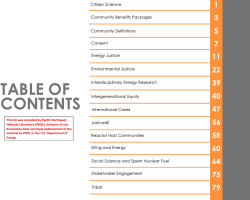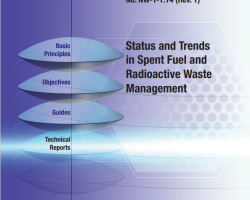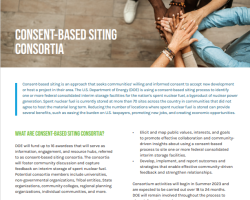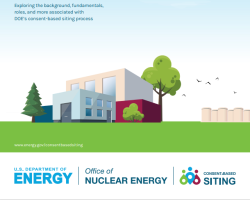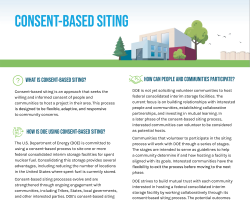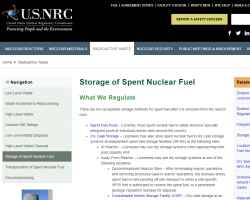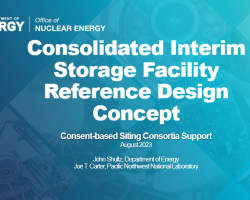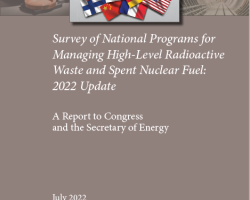Category of Content
Siting Experience Documents Only
Publication Date
Subject Matter
Keywords
WCS Presentation Slides to NRC 8-22-16
WCS Presentation Slides to NRC 8-22-16
WCS Presentation slides for NRC meeting held 8-22-16 to discuss the status of responses to NRC Requests for Supplemental Information.
Interim Storage, Environmental Justice, and Generational Equity
Interim Storage, Environmental Justice, and Generational Equity
With the termination of the Yucca Mountain project, which was proposed to be our nation’s first repository for the disposal of military and civilian spent nuclear fuel and high-level radioactive waste, the future of nuclear waste management and disposal in this country became increasingly uncertain. Interim storage has been advocated by many as a temporary solution while a permanent solution is studied for potentially several more decades to come.
Fostering stakeholder involvement across generations - participation after site selection
Fostering stakeholder involvement across generations - participation after site selection
In October 2022, the NEA Forum on Stakeholder Confidence (FSC) organised, in collaboration with the Belgian Agency for Radioactive Waste and Enriched Fissile Materials (ONDRAF/NIRAS), a national workshop in Dessel, Belgium, to explore the topic of stakeholder involvement across generations.
Building on previous work on this topic, participants gathered to discuss how to keep local communities involved in radioactive waste management after site selection, how to engage youth as key stakeholders and which approaches can be used to communicate with stakeholders now and in the future.
The Morally Desirable Option for Nuclear Power Production
The Morally Desirable Option for Nuclear Power Production
This paper reflects on the various possible nuclear power production methods from an ethical perspective. The production and consumption of nuclear power give rise to the problem of intergenerational justice; in other words, we are depleting a nonrenewable resource in the form of uranium while the radiotoxic waste that is generated carries very long-term potential burdens. I argue that the morally desirable option should therefore be to seek to safeguard the interests of future generations.
Communicating Risks and Benefits: An Evidence-Based User's Guide
Communicating Risks and Benefits: An Evidence-Based User's Guide
Effective risk communication is essential to the well-being of any organization and those people who depend on it. Ineffective communication can cost lives, money, and reputations. Communicating Risks and Benefits: An Evidence-Based User's Guide provides the scientific foundations for effective communication.
Reset of America's Nuclear Waste Management Strategy and Policy
Reset of America's Nuclear Waste Management Strategy and Policy
The U.S. nuclear waste management program has labored for decades at a cost of billions of dollars each year, and yet there is still no active disposal program either for spent nuclear fuel from commercial reactors or for the high-level radioactive legacy waste and spent nuclear fuel from defense programs.
U.S. Nuclear Plant Shutdowns, State Interventions, and Policy Concerns
U.S. Nuclear Plant Shutdowns, State Interventions, and Policy Concerns
The United States has the largest nuclear power plant fleet in the world, with 93 reactors that can generate approximately 95,522 megawatts (MW) of electricity. Nuclear power has accounted for about 20% of annual U.S. electricity generation since the late 1980s; in 2020 it was 19.7%. However, the U.S. nuclear power industry in recent years has been facing economic and financial challenges, particularly plants located in competitive power markets where natural gas and renewable power generators influence wholesale electricity prices. Twelve U.S.
Interim Storage, Environmental Justice, and Generational Equity
Interim Storage, Environmental Justice, and Generational Equity
With the termination of the Yucca Mountain project, which was proposed to be our nation’s first repository for the disposal of military and civilian spent nuclear fuel and high-level radioactive waste, the future of nuclear waste management and disposal in this country became increasingly uncertain. Interim storage has been advocated by many as a temporary solution while a permanent solution is studied for potentially several more decades to come.
Transportation Planning: Indigenous Dialogue
Transportation Planning: Indigenous Dialogue
In 2019, the NWMO commissioned Maawandoon Inc to lead Indigenous Dialogue session to support NWMO’s transportation planning for the long-term care of Canada’s used nuclear fuel. This research built upon and complemented public attitude research carried out in 2017 and 2018. The research methodology consisted of 7 Indigenous dialogue sessions and attendance at 3 Indigenous Annual General Assemblies (AGA)/meetings with dialogue components.
Energy Justice and Social Science Nuclear Waste Literature
Energy Justice and Social Science Nuclear Waste Literature
This spreadsheet provides a list of documents that national laboratory staff found through a search of the literature on social and behavioral science and environmental justice issues related to spent nuclear fuel and nuclear waste. The review was conducted from 2022 to mid-2023. It sorts the references into themes identified in the table of contents. Papers that fit more than one theme may be listed in more than one section.
Status and Trends in Spent Fuel and Radioactive Waste Management
Status and Trends in Spent Fuel and Radioactive Waste Management
Status and Trends in Spent Fuel and Radioactive Waste Management is a collaborative project between the IAEA, the European Commission and the OECD Nuclear Energy Agency, with the participation of nuclear industry organization the World Nuclear Association, that aims to consolidate and complement the information gathered from different initiatives around the world.
SONGS Strategic Plan, Conceptual Transportation Plan, and Action Plan
SONGS Strategic Plan, Conceptual Transportation Plan, and Action Plan
Summarize alternatives for moving SONGS SNF offsite to an interim storage facility or repository. Describe the process for preparing for transporting canisters offsite. Summariz the SCE Action plan for making progress to move SNF offsite.
Getting to the Core of the Nuclear Fuel Cycle: From the mining of uranium to the disposal of nuclear waste
Getting to the Core of the Nuclear Fuel Cycle: From the mining of uranium to the disposal of nuclear waste
This brochure shortly describes the various steps of the nuclear fuel cycle by covering areas from mining and milling to disposal of spent fuel and other radioactive waste.
Consent-Based Siting Consortia flyer
Consent-Based Siting Consortia flyer
Consent-based siting is an approach that seeks communities’ willing and informed consent to accept new development or host a project in their area. The U.S. Department of Energy (DOE) is using a consent-based siting process to identify one or more federal consolidated interim storage facilities for the nation’s spent nuclear fuel, a byproduct of nuclear power generation. Spent nuclear fuel is currently stored at more than 70 sites across the country in communities that did not agree to host the material long term.
Consent-Based Siting Process for Federal Consolidated Interim Storage of Spent Nuclear Fuel
Consent-Based Siting Process for Federal Consolidated Interim Storage of Spent Nuclear Fuel
In this document, the U.S. Department of Energy (DOE) outlines its road map for implementing a consent-based siting process to site one or more federal consolidated interim storage facilities for spent nuclear fuel.
Consent-Based Siting flyer
Consent-Based Siting flyer
What is Consent-Based Siting?
Consent-based siting is an approach that seeks the willing and informed consent of people and communities to host a project in their area. This process is designed to be flexible, adaptive, and responsive to community concerns.
How is DOE using Consent-Based Siting? How can people and communities participate?
Spending Time on Spent Nuclear Fuel
Spending Time on Spent Nuclear Fuel
Making progress on the long-term management of spent nuclear fuel can be fraught with political and economic challenges, but groups within the U.S. are looking to try and tackle the challenge from many different angles. As the government ramps up efforts to support spent nuclear fuel management up to the limits of the law, ANS and others are making recommendations around, and receiving funding oriented to, pathways for progress.
Spent Nuclear Fuel and Reprocessing Waste Inventory, Revision 9
Spent Nuclear Fuel and Reprocessing Waste Inventory, Revision 9
This report provides information on the inventory of spent nuclear fuel (SNF) in the United States located at Nuclear Power Reactor and Independent Spent Fuel Storage Installation sites, as well as SNF and reprocessing waste located at U.S. Department of Energy sites and other research and development centers as of the end of calendar year 2021.
Summary of Consolidated Interim Storage Advantages and Disadvantages from an Integrated Systems Perspective from Prior Reports and Studies
Summary of Consolidated Interim Storage Advantages and Disadvantages from an Integrated Systems Perspective from Prior Reports and Studies
The question of whether centralized storage of civilian spent nuclear fuel (SNF) should be part of the federal waste management system as an intermediate step before permanent disposal has been debated for more than four decades. Centralized storage facilities were included as a potential component of the U.S. spent fuel management system in the Nuclear Waste Policy Act of 1982 (NWPA), but the NWPA did not identify these facilities as being essential.
NRC Online Resources - Storage of Spent Nuclear Fuel Webpage
NRC Online Resources - Storage of Spent Nuclear Fuel Webpage
NRC's "Storage of Spent Nuclear Fuel" includes a short discussion of "What We Regulate"; "How We Regulate"; and links to related information.
Consolidated Interim Storage Facility Reference Design Concept
Consolidated Interim Storage Facility Reference Design Concept
Presentation slides on the Consolidated Interim Storage Facility Reference Design Concept, including site plans; handling, inspection and repackaging concepts and facilities; and cost and staffing estimates.
A Journey Through a Hypothetical Consolidated Interim Storage Facility
A Journey Through a Hypothetical Consolidated Interim Storage Facility
The hypothetical facility shown in this animation has not been sited or licensed. It is one concept intended only to demonstrate what a potential federal consolidated interim storage facility for commercial spent nuclear fuel could look like based on a set of operating assumptions.
Survey of National Programs for Managing High-Level Radioactive Waste and Spent Nuclear Fuel: 2022 Update
Survey of National Programs for Managing High-Level Radioactive Waste and Spent Nuclear Fuel: 2022 Update
In October 2009, the U.S. Nuclear Waste Technical Review Board (Board or NWTRB) published Survey of National Programs for Managing High-Level Radioactive Waste and Spent Nuclear Fuel. For each of the 13 national programs studied, the report catalogued 15 institutional arrangements that had been set in place and 15 technical approaches that had been taken to design repository systems for the long-term management of high-activity radioactive waste.
Socio-technical multi-criteria evaluation of long-term spent nuclear fuel management strategies: A framework and method
Socio-technical multi-criteria evaluation of long-term spent nuclear fuel management strategies: A framework and method
In the absence of a federal geologic repository or consolidated, interim storage in the United States, commercial spent fuel will remain stranded at some 75 sites across the country. Currently, these include 18 “orphaned sites” where spent fuel has been left at decommissioned reactor sites.
